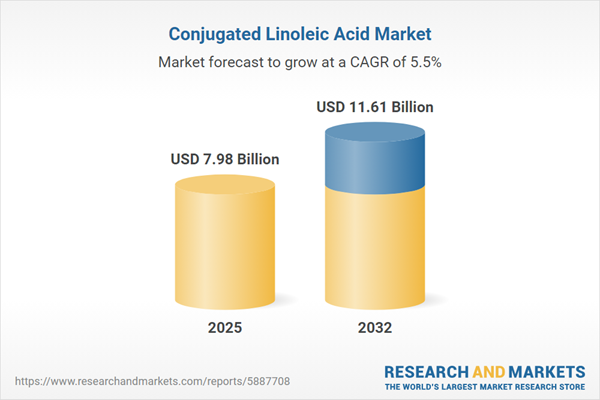Speak directly to the analyst to clarify any post sales queries you may have.
The conjugated linoleic acid market is evolving rapidly as sustainability, traceability, and tightening regulations drive companies to reexamine sourcing and operational strategies. Senior executives are focused on maintaining compliance, optimizing resilience, and leveraging innovation to secure growth in this dynamic sector.
Market Snapshot: Conjugated Linoleic Acid Market Performance and Outlook
The conjugated linoleic acid market is projected to increase from USD 7.56 billion in 2024 to USD 7.98 billion by 2025, with expectations to reach USD 11.61 billion by 2032. This growth reflects a compound annual growth rate of 5.50% and is propelled by persistent demand across nutritional supplements, pharmaceuticals, and animal feed. Companies are responding with enhanced product innovation and advanced formulations that address client needs for transparency and cleaner ingredients. Ongoing regulatory initiatives are influencing organizations to upgrade their agility in supply chain management and refine compliance protocols, reinforcing competitiveness on a global scale.
Scope & Segmentation: Mapping Opportunity in the Conjugated Linoleic Acid Market
- Source Types: Dairy-derived, vegetable oil sources, and synthetic options fulfill sustainability and traceability requirements, providing a tailored approach to varying customer expectations and regulatory environments.
- Distribution Channels: Specialty retail, mass-market outlets, pharmacies, convenience stores, direct-to-consumer, and third-party e-commerce platforms enable strategic engagement across different regions and client segments.
- Applications: Use across animal nutrition, dietary supplements, functional foods, bakery, dairy, confectionery, and beverage categories supports a broad product portfolio, capturing both mainstream and niche market needs.
- Form Factors: Hard and soft capsules, softgels, standard or micronized powders, and liquid options expand compliance options and address diverse consumption patterns in core and emerging geographies.
- Regions Covered: Americas, Europe, Middle East & Africa, and Asia-Pacific, with a focus on China, India, Japan, and Australia for localized risk mitigation and sustainable expansion.
- Leading Companies: BASF SE, Cargill Incorporated, Archer Daniels Midland Company, Stepan Company, Koninklijke DSM N.V., Nisshin OilliO Group, A&A Fratelli Parodi S.p.A., Lipoid GmbH, Zhejiang Medicine Co., Ltd., and Mitsubishi Corporation drive progress through ongoing innovation and product development initiatives.
- Technological Developments: Supercritical CO₂ extraction, enzymatic and fermentation processes, and AI-based analytics strengthen supply reliability, streamline compliance workflows, and increase operational adaptability.
Key Takeaways: Strategic Insights for Senior Decision-Makers
- Strengthening sustainable sourcing, combined with advanced extraction processes, allows organizations to keep pace with evolving regulatory requirements and environmental standards.
- Diversified supply chain frameworks and region-specific strategies improve reliability and minimize the likelihood of disruption when accessing established and high-potential markets.
- Balancing natural and synthetic sources across multiple product forms supports traceability objectives and effective navigation of market-specific compliance landscapes.
- Integrating digital and traditional distribution pathways enables targeted engagement for organizations managing operations across global markets.
- Collaboration between research, engineering, manufacturing, and analytics teams is vital for ensuring compliance and reacting efficiently to changing operational or regulatory circumstances.
- Continued investment in process technology and supply chain management facilitates operational scale, supporting greater resilience against fluctuations in external market factors.
Tariff Impact on Supply Chain and Market Access
Anticipated United States tariffs scheduled for 2025 are expected to raise costs throughout the conjugated linoleic acid value network. To offset increased expenses, industry leaders are emphasizing domestic procurement, establishing regional hubs, and prioritizing local manufacturing. Agile procurement strategies and proactive policy surveillance remain crucial for maintaining uninterrupted access and mitigating emerging market risks.
Methodology & Data Sources
Findings are based on peer-reviewed journals, industry databases, corporate disclosures, and stakeholder interviews. Strategic frameworks, scenario planning, thorough SWOT analysis, and strict data validation have been employed to ensure credible, actionable insights for senior decision-makers.
Why This Report Matters
- Granular segmentation empowers leaders to pinpoint opportunities within complex supply chains and target resources for optimal operational impact.
- Strategic frameworks facilitate compliance and flexible distribution, aiding organizations in capitalizing on market shifts and regulatory transitions.
- Evidence-based insights fuel collaboration across management, supply chain, and regulatory functions—supporting coordinated, proactive responses to sector changes.
Conclusion
In a transforming conjugated linoleic acid landscape, regulatory compliance and innovation are central to resilience and growth. Senior decision-makers who prioritize collaborative networks and adaptive technologies will foster sustained progress and operational stability.
Additional Product Information:
- Purchase of this report includes 1 year online access with quarterly updates.
- This report can be updated on request. Please contact our Customer Experience team using the Ask a Question widget on our website.
Table of Contents
3. Executive Summary
4. Market Overview
7. Cumulative Impact of Artificial Intelligence 2025
Companies Mentioned
The companies profiled in this Conjugated Linoleic Acid market report include:- BASF SE
- Cargill, Incorporated
- Archer Daniels Midland Company
- Stepan Company
- Koninklijke DSM N.V.
- Nisshin OilliO Group, Ltd.
- A&A Fratelli Parodi S.p.A.
- Lipoid GmbH
- Zhejiang Medicine Co., Ltd.
- Mitsubishi Corporation
Table Information
| Report Attribute | Details |
|---|---|
| No. of Pages | 198 |
| Published | November 2025 |
| Forecast Period | 2025 - 2032 |
| Estimated Market Value ( USD | $ 7.98 Billion |
| Forecasted Market Value ( USD | $ 11.61 Billion |
| Compound Annual Growth Rate | 5.5% |
| Regions Covered | Global |
| No. of Companies Mentioned | 11 |









